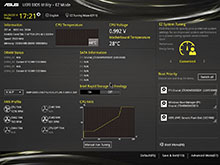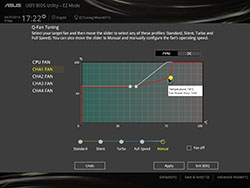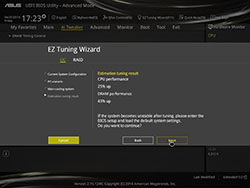Getting the obvious out of the way, the 9-series Asus boards look a heck of a lot better than the overly-yellow, gaudy offerings from last year. This time around, the design is understated and rather more functional-looking.
There's not a whole lot of innovation left in ATX motherboard design. What we're really looking for are genuine differences between this and last year's board. Asus has redesigned the chipset heatsink into a low-profile, fanless model that catches the eye, replacing the square heatsink of the Z87-A.
A couple of chunky heatsinks match the general aesthetic and are a little more substantial than the Z87-A's. On first glance, this board feels and looks better than its immediate predecessor. But similarities exist, as power is provided via an 8-phase supply, compared to 10, or more, for higher-end boards. This may come into play when pushing the CPU to the limit.
The obvious upside of Z97 is baked-in support for the M.2 storage form factor, represented here slap-bang in the middle of the board. Asus has relocated the CMOS battery to make adequate room for the slot but, importantly, hasn't curtailed any of the expansion slots in the transition from one generation to the next.
A lack of chipset PCIe lanes translates to compromises on the expansion front. You can use either the M.2 slot in x2 mode or the two PCIe x1 slots, not both concurrently. The choice is made in the BIOS and isn't optimal.
Three full-length x16 PCIe 3.0 slots sandwich a couple of legacy PCIc. The top two PCIe are bifurcated to x8 when using two Nvidia or AMD graphics cards in tandem. The bottom x16 is more of an afterthought, really, with transfers at a maximum of x2. We're not convinced that having regular PCI makes sense any more, as it raises cost (a bridge chip is needed) and is of little value for a modern build.
We don't mark Asus down for not having enthusiast-class features such as debug LED or voltage-monitoring points on a board pitched at £100. Making the most of the additional storage support present in Z97, Asus also beefs up the SATA side of things with a SATA Express connector, which takes the place of two regular SATA 6Gbps ports present on Z87-A, reducing their available count to four.
Audio, too, gets a jump over the previous generation. Now powered by the Realtek ALC892 Codec and using the latest iteration of 'Crystal Sound' technology, it comes complete with EMI shielding for better performance, auto-impedence settings for headphones and the use of Nichicon audio capacitors.
As a nod towards improving Ethernet capability, Asus has gone back to Intel for LAN duties, supplanting Realtek from the Z87-A. According to Asus' engineers, Intel's LAN provides better gaming and packet-prioritising performance than cheaper alternatives. On the rear, video outputs include a choice of DVI, HDMI, DisplayPort and VGA, and three can be used at once.
The board also supports Asus' NFC Express 2 and Wireless Charging (Qi-compatible) boxes, available separately. Last but not least, Asus knows that the Z97 transition isn't chock-full of features from a hardware point of view. Strengthening the software, the Dual Intelligent Processors get an upgrade. Now referred to as version 5, a new feature called Turbo App is debuted for Z97 boards. Turbo App provides fine-grained control over overclocking/controlling the CPU - for example, you can set the speed of the CPU cores on a per-app basis, control the fans (per the BIOS) and generally tinker with an incredible number of settings right inside Windows.
BIOS
Asus has also overhauled the BIOS in moves between chipsets. This new full-UEFI version is slick and intuitive. Fan control, in particular, is very good, enabling you to pull and push the speeds for super-granular control. There's also an EZ Tuning Wizard whose purpose it is to make overclocking a cinch for novice users - simply run the wizard and select the usage scenario of the PC, define the cooler, and then Asus computes the probable overclock. It's seems optimistic, in our opinion, as running the RAM 43 per cent faster than DDR3-1,866 is highly improbable.
Stay tuned, we'll have a full review of Asus' Z97-A ready for your delectation in the near future.


















